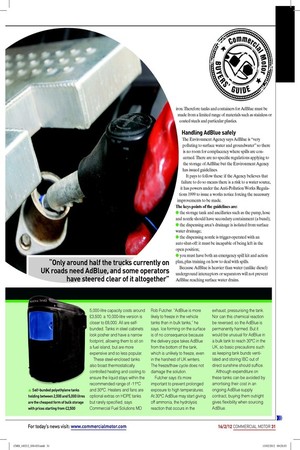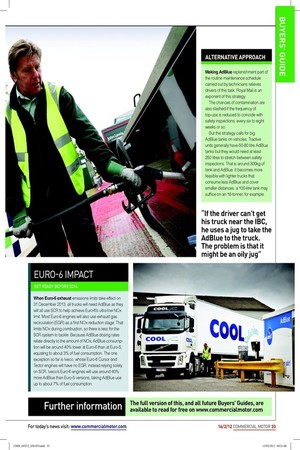BUYERS’ GUIDE
Page 25

Page 26

Page 27

Page 28

If you've noticed an error in this article please click here to report it so we can fix it.
THIS WEEK WE BUY...
Full guide available at www.commercialmotor.com
What are the best methods for buying, storing, handling and dispensing it? CM gives you the lowdown on AdBlue
The word AdBlue irst began to crop up in our vocabulary in 2003. It had been coined as a trademark by the German automotive industry association, the VDA (Verband de Automobilindustrie). The VDA wanted a standard for a urea solution that was soon to be widely adopted by CV manufacturers poised to comply with Euro-4 exhaust emission limits, which took effect for all new trucks registered from October 2006.
Since then we have witnessed the birth of an entire AdBlue industry.
Only around half the trucks currently on UK roads need AdBlue and some operators have steered clear of it altogether. But that option looks like disappearing in a few years’ time...
The chemistry bit
Although sometimes described as a fuel additive, AdBlue is nothing of the sort: AdBlue and diesel should be kept well apart. It is more correctly described as a re-agent, needed for selective catalytic reduction (SCR) systems. When sprayed into a hot exhaust stream, AdBlue gives off ammonia gas that reacts with the SCR catalyst to convert NOx (oxides of nitrogen) in the exhaust gases into harmless nitrogen and water.
The generic description of AdBlue is AUS32 – aqueous urea solution 32.5%. As a urea solution in demineralised water its chemistry is deined in the international standard ISO 22241, which stipulates that it must contain 32.5% (plus or minus 0.7%) urea by weight.
With a speciic density of 1.09, it is 9% heavier than water.
Although classiied as non-hazardous, it is corrosive to some metals such as aluminium alloys, copper, bronze and iron. Therefore tanks and containers for AdBlue must be made from a limited range of materials such as stainless or coated steels and particular plastics.
Handling AdBlue safely
The Environment Agency says AdBlue is “very polluting to surface water and groundwater” so there is no room for complacency where spills are concerned. There are no speciic regulations applying to the storage of AdBlue but the Environment Agency has issued guidelines.
It pays to follow these: if the Agency believes that failure to do so means there is a risk to a water source, it has powers under the Anti-Pollution Works Regulations 1999 to issue a works notice forcing the necessary improvements to be made.
The keys points of the guidelines are: ● the storage tank and ancillaries such as the pump, hose and nozzle should have secondary containment (a bund); ● the dispensing area’s drainage is isolated from surface water drainage; ● the dispensing nozzle is trigger-operated with an auto shut-off: it must be incapable of being left in the open position; ● you must have both an emergency spill kit and action plan, plus training on how to deal with spills.
Because AdBlue is heavier than water (unlike diesel) underground interceptors or separators will not prevent AdBlue reaching surface water drains.
STORAGE AND DISPENSING
ft makes sense for operators to invest in their own on-site supply. There is a range of storage and dispensing options, from a 210-litre drum with a hand-operated pump, right up to a 15,000-litre bulk tank with overflow and spill alarms, plus a telemetry system that places repeat orders when stock level reaches a pre-determined minimum. The volume of AdBlue consumed will determine which option is the most appropriate.
A single tractor unit covering 120,000km a year uses 35,00045,000 litres of diesel annually. If AdBlue is consumed at the typical rate of 5% of diesel consumption, annual usage amounts to 1,750-2,250 litres. Shelf life of AdBlue is reckoned to be about 12 months before its condition deteriorates to any significant degree. So in this case, a 1,000-litre palletised intermediate bulk container (IBC) would last six months, fitting the bill nicely. A couple of ancillary pieces of kit are also needed. A manual pump and dispensing hose costs £100-£150; an electric version is £350-£400. And in case the IBC leaks it should stand on a sump or spill-pallet with a capacity of at least 1,100 litres. This will cost £400-500. And don’t forget spill equipment, such as drain covers and absorbent mats.
Commercial Fuel Solutions of Southampton, which claims to be the UK’s largest independent AdBlue distributor, suggests that once AdBlue consumption exceeds one IBC per month (12,000 litres a year) it is worth installing a bulk storage tank. The reduction in cost per litre recoups the cost of the tank. Although there are smaller tanks on the market, 2,5000 litres is the smallest practical option because many AdBlue distributors set 2,000 litres as their minimum bulk delivery. Doubling tank capacity to 5,000 litres permits larger deliveries, attracting a discount of a penny or two on each litre.
A typical 2,500-litre moulded high density polyethylene (HDPE) AdBlue tank costs £2,500-£3,000. That includes ancillaries such as the electric pump, flow-meter, delivery hose and spill/over-fill alarms. Something similar with a 5,000-litre capacity costs around £3,500: a 10,000-litre version is closer to £6,000. All are selfbunded. Tanks in steel cabinets look posher and have a narrow footprint, allowing them to sit on a fuel island, but are more expensive and so less popular.
These steel-enclosed tanks also boast thermostatically controlled heating and cooling to ensure the liquid stays within the recommended range of -11°C and 30°C. Heaters and fans are optional extras on HDPE tanks but rarely specified, says Commercial Fuel Solutions MD Rob Futcher. “AdBlue is more likely to freeze in the vehicle tanks than in bulk tanks,” he says. Ice forming on the surface is of no consequence because the delivery pipe takes AdBlue from the bottom of the tank, which is unlikely to freeze, even in the harshest of UK winters. The freeze/thaw cycle does not damage the solution.
Futcher says it’s more important to prevent prolonged exposure to high temperatures. At 30°C AdBlue may start giving off ammonia, the hydrolysis reaction that occurs in the exhaust, pressurising the tank. Nor can this chemical reaction be reversed, so the AdBlue is permanently harmed. But it would be unusual for AdBlue in a bulk tank to reach 30°C in the UK, so basic precautions such as keeping tank bunds ventilated and storing IBC out of direct sunshine should suffice.
Although expenditure on these tanks can be avoided by amortising their cost in an ongoing AdBlue supply contract, buying them outright gives flexibility when sourcing AdBlue.
PRICING
There is strong correlation between the price per litre of AdBlue and the quantity bought. AdBlue in 10-litre containers is likely to cost up to £1/litre. There are around 130 fuel stations and truckstops with AdBlue pumps for roadside refills. The typical price at these is around 60-75p/litre.
When bought in 210-litre drums, AdBlue is around 60p/litre, depending on the number of drums in the delivery. This price includes the delivery charge. Prices tumble to around 35-40p/litre (including delivery costs) when AdBlue is bought in an IBC. Bulk AdBlue delivered by tanker is the cheapest option, costing 25p-30p/litre.
The price of AdBlue rose by about 3p/litre late last year thanks to a hike in the urea price. “Urea accounts for about 40% of the cost of AdBlue,” explains Chris Haynes, UK MD of AdBlue supplier Greenchem Solutions. Haynes reckons that the UK AdBlue market is at a relatively early stage of development because around half the trucks on the road still do not need it.
The AdBlue market will climb steadily over the next few years as older trucks drop out of circulation. Will AdBlue prices rise as demand grows? Not necessarily, argues Haynes. “Only about 5% of the world’s production of urea goes into AdBlue,” he explains. “Over 90% goes into fertiliser, so that’s what influences the price.” Haynes expects rising energy costs and general inflation to push up AdBlue prices in the long term.
CONTAMINATION AND SUB-STANDARD ADBLUE
Just a few drops of oil in AdBlue may lead to costly SCR system failures. European truck manufacturers and AdBlue suppliers last year launched a joint campaign, ‘AdBlue – Add Care’, highlighting the twin dangers of contamination and buying sub-standard solution from unlicensed makers. “We are seeing contamination issues,” said Teun de Bruijn, chief executive of Dutch AdBlue supplier Greenchem, explaining that most contamination is from oil or diesel getting into AdBlue, poisoning delicate SCR catalysts.
“Many operators don’t realise how scrupulously clean AdBlue must be kept,” explains Paul Norman, UK market manager at Yara, manufacturer of Air1 branded AdBlue. He believes contamination most commonly arises when AdBlue is drawn from an IBC in a workshop.
“If the driver can’t get his truck near the IBC he uses a jug to take the AdBlue to the truck. The problem is that it might be an oily jug.” Norman reasons there is a lower contamination risk if AdBlue is dispensed directly into the vehicle from an external bulk tank or IBC.
Anyone can make a quick buck from ‘stretching’ AdBlue by adding tap-water. However, the consequences will prove expensive as the calcium in the water accumulates on the SCR catalyst, gradually blocking it. This is why the AdBlue campaign emphasised the importance of buying product sourced only from one of the 80 or so manufacturers licensed by the VDA to make AdBlue.
Any solution described as AdBlue must originate from these licensed suppliers: the AdBlue name guarantees that it meets the ISO standard. It is possible to buy urea solution with the word ‘blue’ in its name but which isn’t AdBlue. Truck manufacturers are likely to reject warranty claims for SCR defects if non-genuine AdBlue is detected.
ALTERNATIVE APPROACH
Making AdBlue replenishment part of the routine maintenance schedule carried out by technicians relieves drivers of this task. Royal Mail is an exponent of this strategy.
The chances of contamination are also slashed if the frequency of top-ups is reduced to coincide with safety inspections, every six to eight weeks or so.
But this strategy calls for big AdBlue tanks on vehicles. Tractive units generally have 50-80 litre AdBlue tanks but they would need at least 250 litres to stretch between safety inspections. That is around 300kg of tank and AdBlue. It becomes more feasible with lighter trucks that consume less AdBlue and cover smaller distances: a 100-litre tank may suffice on an 18-tonner, for example.
EURO-6 IMPACT
GET READY BEFORE 2014 When Euro-6 exhaust emissions limits take effect on 31 December 2013, all trucks will need AdBlue as they will all use SCR to help achieve Euro-6’s ultra-low NOx limit. Most Euro-6 engines will also use exhaust gas recirculation (EGR) as a first NOx reduction stage. That limits NOx during combustion, so there is less for the SCR system to tackle. Because AdBlue dosing rates relate directly to the amount of NOx, AdBlue consumption will be around 40% lower at Euro-6 than at Euro-5, equating to about 3% of fuel consumption. The one exception so far is Iveco, whose Euro-6 Cursor and Tector engines will have no EGR, instead relying solely on SCR. Iveco’s Euro-6 engines will use around 40% more AdBlue than Euro-5 versions, taking AdBlue use up to about 7% of fuel consumption.














































